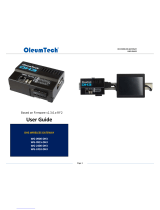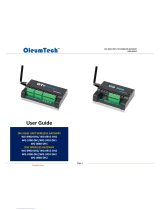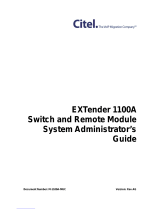Packet Power WCGP5EG3 Manuel utilisateur
- Catégorie
- Séparateurs vidéo
- Taper
- Manuel utilisateur
Ce manuel convient également à

Packet Power, LLC
233 Park Avenue, Suite 203
Minneapolis, MN 55415
1-877-560-8770
Email: info@packetpower.com
www.packetpower.com
NOTES
Read all instructions carefully prior to installation.
No field-serviceable parts. Do not attempt to disassemble the product as
potentially severe electrical shock may result. Installation and maintenance must
be performed by qualified personnel.
Follow basic safety precautions to reduce the risk of electrical shock and damage
to equipment.
Store in a clean, dry location. Clean with a dry cloth.
Intended for indoor use only, do not install in a wet location.
Adhere to all local electrical codes and guidelines.

REGULATORY INFORMATION
This product has been certified to meet the following requirements:
UL / ANSI standards 61010-1,Second Edition, Dated July 12, 2004 with revisions through and including October 28,
2008
CAN/CSA-C22.2 No. 61010-1, second edition, including Amendment 1, or a later version of the same standard
incorporating the same level of testing requirements.
Council Directive 2006/95/EC (December 12, 2006) on Low Voltage Equipment Safety; IEC 61010-1:2001 (Second
Edition) and EN 61010-1:2001 (Second Edition)
Council Directive 1999/05/EC - European Union (EU) Radio & Telecommunications Terminal Equipment Directive
(R&TTE) ETSI EN 300 220-2, Issued:2006/04/01 and ETSI EN 301 489-3, Issued:2002/08/01 V1.4.1
Council Directive 2004/108/EC (December 15, 2004) on Electromagnetic Compatibility CENELEC EN 61326-1
Issued:2006/05/01; IEC 61326-1:2005;:1997 –
AS/NZS 4268: 2008
Class B Device Statement / FCC Regulations:
Section 15.105(a) of the FCC Rules: This equipment has been tested and found to comply with the limits for a Class B digital
device, pursuant to part 15 of the FCC Rules. These limits are designed to provide reasonable protection against harmful
interference when the equipment is operated in a commercial environment. This equipment generates, uses, and can radiate radio
frequency energy and, if not installed and used in accordance with the instruction manual, may cause harmful interference to radio
communications.
Section 15.19 of the FCC Rules: This device complies with part 15 of the FCC Rules. Operation is subject to the following two
conditions: (1) This device may not cause harmful interference, and (2) this device must accept any interference received, including
interference that may cause undesired operation.
Pursuant to Part 15.21 of the FCC Rules, any changes or modifications to this product not expressly approved by Packet Power
LLC might cause harmful interference and void the FCC authorization to operate this product.
Pursuant to part 2.1091c of the FCC rules device is categorically excluded from routine RF Exposure regulations.
Industry Canada (IC) Compliance Statement
This device complies with Industry Canada license-exempt RSS standard(s). Operation is subject to the following two conditions:
(1) This device may not cause interference, and (2) this device must accept any interference, including interference that may cause
undesired operation of the device.
Under Industry Canada regulations, this radio transmitter may only operate using an antenna of a type and maximum (or lesser)
gain approved for the transmitter by Industry Canada. To reduce potential radio interference to other users, the antenna type and
its gain should be so chosen that the equivalent isotropically radiated power (e.i.r.p.) is not more than that necessary for successful
communication.
Per section RSS-102, 2.5 of Industry Canada regulations, this device is categorically excluded from Routine Evaluation Limits.
Industrie Canada (IC) Déclaration de conformité
Le présent appareil est conforme aux CNR d'Industrie Canada applicables aux appareils radio exempts de licence. L'exploitation
est autorisée aux deux conditions suivantes : (1) l'appareil ne doit pas produire de brouillage, et (2) l'utilisateur de l'appareil doit
accepter tout brouillage radioélectrique subi, même si le brouillage est susceptible d'en compromettre le fonctionnement.
Conformément à la réglementation d'Industrie Canada, le présent émetteur radio peut fonctionner avec une antenne d'un type et
d'un gain maximal (ou inférieur) approuvé pour l'émetteur par Industrie Canada. Dans le but de réduire les risques de brouillage
radioélectrique à l'intention des autres utilisateurs, il faut choisir le type d'antenne et son gain de sorte que la puissance
ipoosotrope rayonnée équivalente (p.i.r.e.) ne dépasse pas l'intensité nécessaire à l'établissement d'une communication
satisfaisante.

Packet Power™ Ethernet Gateway Version 3 Product Manual
Copyright 2014 © Packet Power, LLC.
1
Overview
The Ethernet Gateway version 3 is the central Gateway by which all Packet Power
monitoring nodes (environmental and power) communicate. This guide is intended to
provide a high level overview of how to commission a Gateway module. Refer to the support
section of www.packetpower.com for additional support.
Introduction to the Gateway
Gateway Placement: Gateway placement is critical. Gateway module(s) should be located 10-30
meters / 30-100 feet from one or more monitoring nodes (ideally line of site). The network is
designed as a mesh network which means that the signal for distant nodes can be relayed through
adjacent nodes until reaching nodes in good radio proximity to the Gateway. Refer to the Gateway
Placement manual on the support section of the website for additional details.
Locate the gateway at a height above monitoring nodes when possible in a location
with the best line of sight view of monitoring nodes.
Do not locate inside metallic cabinets or directly on metal surfaces
Use the Gateway mounting bracket for optimal placement and signal strength.
Redundant Gateways are advised for any critical environment; additional Gateways
should be placed in midway or in the opposite end of the device constellation when
possible.
Gateway Types: There are various Gateway models. These include the standard Gateway designed
to communicate exclusively with the Packet Power EMX portal, Modbus TCP/IP output versions
(enterprise and solo), and SMNP output versions (solo and enterprise). All Gateway versions can
communicate with the EMX portal simultaneously (i.e. a Modbus version can provide ModBus TCP/IP
output as well as communicate with the EMX portal simultaneously).
Gateway Facts: One Gateway can support up to 300 nodes (node count will affect polling time). The
network is self-configuring and will auto recognize new nodes added. Multiple Gateways can be used
within a network for capacity or redundancy and will automatically load balance the nodes.
Updates: The Gateway firmware is capable of being remotely updated over the network. Consult the
support section of the website for additional details.
Security: The Packet Power network is designed to be the most secure monitoring system available
with many inherent security features exclusive to the architecture that limit any possibility of
penetration through the wireless nodes onto the host network. Additionally the Gateway can be
equipped with 128 bit encryption. Contact Packet Power for additional details.

Packet Power™ Ethernet Gateway Version 3 Product Manual
Copyright 2014 © Packet Power, LLC.
2
Device Setup
Connect the Gateway to a router (using a standard network cable) with network access using
the Ethernet port on the back of the Gateway.
Connect the power supply provided or any 5 VDC source to the DC input of the Gateway.
The Gateway can be powered using PoE (Power over Ethernet) using a splitter and 5VDC
PoE source.
Once energized the Gateway will indicate it’s firmware version, then device ID number (also
found on the top label of the Gateway) followed the IP address (may be blank if operating
DHCP mode); note that the IP address may take up to two minutes to display.
POWER UP DISPLAY SEQUENCE
FIRMWARE
VERSION
DEVICE ID
IP ADDRESS

Packet Power™ Ethernet Gateway Version 3 Product Manual
Copyright 2014 © Packet Power, LLC.
3
Menu Access and Navigation
To access the menu for the Gateway, press and hold the selector button on the back of the device for
three seconds. To navigate the menu, use short clicks of the selection button; to change a setting or
advance into a menu item press and hold the button. The menu tree is shown in the table below.
GATEWAY MENU TREE
SET IP ADDRESS
DHCP [ON]
DHCP [OFF]
IP
NETMASK
GATEWAY
DNS
REBOOT
EXIT - HOLD BUTTON TO EXIT – WILL INDICATE DEVICE IS REBOOTING
UPDATE
IP
NETMASK
GATEWAY
TFTP
DOWNLOAD
RESTORE FACTORY SETTINGS
TEST PIN
RESET
Setting an IP Address
To configure the IP address of the Gateway, enter the setup menu by pressing and holding
the “selection button” for three seconds.
Use short clicks of the button to advance through the menu until the [-> Set IP] option
appears. Click and hold [-> Set IP].
The LCD will show DHCP:On -or- DHCP:Off. Click and hold the button to toggle between
DHCP on and off.
To set a static IP address click and hold DHCP:Off. The display will then show CP: Off <- .
Click and hold the button and the IP address will appear. Use short clicks to scroll through
specific digits of the IP address. Click and hold the button to change the underlined number
of the IP address.
Once the correct IP address is entered you can exit the IP address console by advancing to
the end of the screen and holding the selector button when the back arrow character <- is
highlighted.

Packet Power™ Ethernet Gateway Version 3 Product Manual
Copyright 2014 © Packet Power, LLC.
4
To properly configure the IP address, the Gateway, Netmask and DNS server address must
also be entered. To change these parameters use the same menu navigation style as
described above.
After the DNS Server address is set you will need to reboot to have
implement your changes. Do this by pressing HOLD when “Reboot”
is displayed. “Booting” will show on the display while the unit reboots
and implements your changes.
To leave the configuration menu without having changes take effect, click and HOLD the
“Exit”.
You can find additional information, including details on the SNMP MIB and Modbus register
map, at www.packetpower.com/support.

Packet Power™ Ethernet Gateway Version 3 Product Manual
Copyright 2014 © Packet Power, LLC.
5
Gateway Placement and Mounting Bracket
The Gateway mounting bracket is designed to allow optimal placement of Gateway
and Environmental Monitor modules away from metallic surfaces and optimize signal
strength. It can be secured to mounting structures using bolts, screws or adhesive
tabs provided.
Bracket with Gateway
Typical Mounting
Configurations: The bracket is
intended for wall mounting or
surface mounting. Orientation
of the Gateway is not critical.
Mounting Surface Dimensions; holes and cut-
outs are intended for use with cable ties for
cable management.

Packet Power™ Ethernet Gateway Version 3 Product Manual
Copyright 2014 © Packet Power, LLC.
6
Device Placement
Never inside of a metal structure (exterior of the rack)
Ideally with-in 30-100 feet of another Packet Power device (gateway or monitoring
module)
2-4” (5-10 cm) away from a large metallic surface or mounted on a non-metallic
platform (use the mounting bracket for optimal placement
Higher is better; always try and locate the monitoring node at the highest point that
allows an unobstructed path to another monitoring node or gateway
Gateway Placement
Gateway module(s) should be located 10-30 meters from one or more
monitoring nodes (ideally line of site).
Locate the gateway at a height above monitoring nodes when possible
Use the same guidelines noted in device placement (do not locate inside
metallic cabinets or directly on metal surfaces)
Use the Gateway mounting bracket for optimal placement and signal strength
Redundant Gateways are advised for any critical environment
One Gateway can support up to 300 Packet Power monitoring devices;
additional Gateways will improve polling speeds
-
 1
1
-
 2
2
-
 3
3
-
 4
4
-
 5
5
-
 6
6
-
 7
7
-
 8
8
-
 9
9
-
 10
10
-
 11
11
Packet Power WCGP5EG3 Manuel utilisateur
- Catégorie
- Séparateurs vidéo
- Taper
- Manuel utilisateur
- Ce manuel convient également à
dans d''autres langues
- English: Packet Power WCGP5EG3 User manual
Autres documents
-
 OleumTech WG-0900-DH3 Manuel utilisateur
OleumTech WG-0900-DH3 Manuel utilisateur
-
 OleumTech WG-2410-DH2 Manuel utilisateur
OleumTech WG-2410-DH2 Manuel utilisateur
-
Cisco Systems WAG54GS Manuel utilisateur
-
Linksys WAG54GX2 Mode d'emploi
-
Linksys WAG354G(EU) Manuel utilisateur
-
 Citel EXTender 1100 System Administrator Manual
Citel EXTender 1100 System Administrator Manual
-
VTech VNT832 Manuel utilisateur
-
Multitech MT200A2EW-H5-WW Mode d'emploi
-
Middle Atlantic Products UPS-OLIPCARD Manuel utilisateur
-
Multitech MTCAP-915-001A Mode d'emploi
















